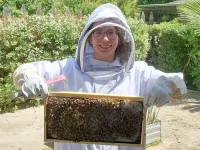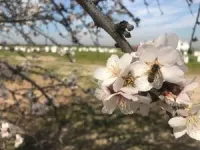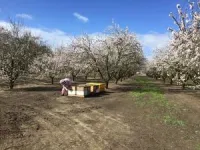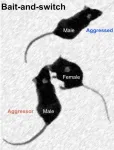(Press-News.org) URBANA, Ill. — As the world’s native bee populations are declining, crop production requiring pollinators increasingly relies on commercial pollination services. In the U.S., the beekeeping industry is in great demand, and truckloads of bee colonies travel the country to accommodate crop growers. A new study from the University of Illinois Urbana-Champaign looks at pollination contracts between beekeepers and California almond growers, exploring clauses that could make the agreements more appealing for both parties.
“There's about 1.3 million acres of almond trees in California, and each acre requires two honeybee hives for pollination, so that’s about 2.6 million honey bee hives every year. They are coming from all over the U.S., making the trek to get there by February 15 when the almonds usually start blooming, and they stay for about a month,” said Brittney Goodrich, assistant professor in the Department of Agricultural and Consumer Economics, part of the College of Agricultural, Consumer and Environmental Sciences at Illinois. Goodrich is the corresponding author on the paper.
Around 90% of the country’s commercial bee colonies congregate in California for almond bloom. The bees spend the rest of the year elsewhere, many in North Dakota or South Dakota for honey production in the summer, and in Texas or Florida during the wintertime.
“You can think of commercial beekeepers as livestock producers who engage in rotational grazing, moving colonies to the places where there are flowers blooming so the bees can find food. I’m interested in how beekeepers deal with risk in their operation and how that affects pollination contracts,” Goodrich said.
Native bee populations are threatened by pesticide use, diseases, and pest problems, as well as monoculture crops and decreased native forage land, leaving crop growers to depend on managed insect pollination.
“We wanted to explore if contracts can include elements that make them more appealing to beekeepers, and whether they would be willing to accept a price discount in exchange for these features. We specifically looked at protection against pesticide exposure, bee-friendly cover crops, and prepayments,” Goodrich explained.
The researchers conducted an online survey with commercial beekeepers who had participated in almond pollination. Respondents were asked to consider a standard contract with a typical pollination fee of $200 per hive, as well as two alternative contract options with different clauses and prices, then choosing which one they preferred. Each respondent made eight contract selections, each time choosing from three contract options. Based on these responses, the researchers were able to estimate the value of each clause.
They found that the pesticide protection clause was the most highly valued, followed by two of the cover crop options. The results were primarily significant for beekeepers who were more risk averse and those who had previous experience with pesticide exposure.
“Usually, fungicides aren’t harmful to honey bees, but they can become synergistically toxic if they are mixed together. We included a contract clause specifying that growers would not tank mix fungicides, and they would only apply at night, when honey bees aren’t foraging so the risk of exposure is low,” Goodrich said.
Overall, beekeepers were willing to accept an $8 discount per colony for pesticide protection, which is about 4% of the total pollination fee per the standard agreement.
“That may not sound like much, but when the average size of the beekeeping operations we surveyed was 5,700 colonies, it adds up quickly,” Goodrich noted.
The beekeepers also valued the presence of flowering cover crops, which can provide additional nutrition that makes the bees more capable of dealing with pesticides, benefitting native bees as well as honey bee colonies. The survey included three cover crop options: clovers, a brassica mix, and a soil builder crop featuring a mix of legumes, brassica, and grasses.
The brassica mix was valued at about $6 per colony, while the soil builder mix was slightly lower. Clovers are typically beneficial for bees, but they bloom later in the season where many of the bees have already left almond orchards, so this option held little value for beekeepers.
“These results are encouraging, because cover crops can also provide soil health benefits for almond growers. However, there are often water shortages in California due to droughts, and growers typically have micro sprinkling systems that only reach the almond trees. There is a risk of paying for cover crop seeds which may not get enough rain to germinate,” Goodrich stated.
That’s why discounts in pollination fees can help alleviate additional costs to plant cover crops and modify pesticide schedules, making these practices more palatable for growers.
The survey also showed that beekeepers value a 40% prepayment before they arrive in California, providing a guaranteed income and working capital to transport the colonies and get them ready for pollination. Goodrich said this is a good option for growers who can afford to pay an upfront fee.
“Our findings show that farmers of pollinated crops can include features that will make pollination contracts more attractive to beekeepers. Maybe it won't necessarily lead to a discount, but it might lead to attracting a beekeeper to your farm that you weren't going to get otherwise,” Goodrich stated. “For beekeepers, this information can provide suggestions for contract negotiations, such as accepting discounts for pesticide protection, cover crops, or prepayment. It helps to know there are ways to obtain mutually beneficial arrangements.”
The paper, “Measuring beekeepers’ economic value of contract enhancements in almond pollination agreements,” is published in Ecological Economics [DOI:10.1016/j.ecolecon.2024.108351]. Authors are Marieke Fenton, Brittney Goodrich, and Jerrod Penn. Support for the research was provided by Project Apis m., the National Honey Board, and the University of California Giannini Foundation of Agricultural Economics.
END
Honey bees in demand: New contract strategies to support pollination services
2024-10-15
ELSE PRESS RELEASES FROM THIS DATE:
New climate change health research center under development at the University of Cincinnati
2024-10-15
Climate change presents far-reaching implications for the planet’s weather, sea levels, animals and food supply. Now experts are addressing climate change’s adverse effects on human health.
“We need to try to reduce risks for people, especially vulnerable populations,” said Ardythe Morrow, PhD, MSc, professor and director of the Epidemiology division of the Department of Environmental and Public Health Sciences at the University of Cincinnati College of Medicine.
To that end, the National Institute of Environmental Health Sciences of the National Institutes of Health has awarded a three-year, $4 million ...
Educational psychologists can play a part in fighting TikTok mental health and neurodiversity misinformation
2024-10-15
Educational psychologists could help to fight mental health and neurodiversity misinformation on TikTok as more young people self-diagnose based on poor quality content on the platform, a new study says.
Growing numbers of young people may be labelling themselves as being neurodivergent or having mental health conditions after engaging with information online, some of which may be inaccurate.
Educational psychologists and their professional bodies could engage with TikTok by creating accessible evidence-based content about neurodiversity and mental health on the platform.
Their assessments could also ...
Winners announced in $300,000 pediatric medical device competition focused on pediatric cardiology
2024-10-15
WASHINGTON (Oct. 15, 2024)—Six medical technology innovators focused on pediatric cardiology were selected to receive grants of $50,000 each in the “Make Your Medical Device Pitch for Kids!TM” competition in Toronto. The funds will help awardees bring their devices to the market and improve care for children with heart conditions.
The awardees, selected from a highly competitive field of ten finalists, are:
Bloom Standard, Minneapolis—Autonomous, hands-free ultrasound
Compremium AG, Bern, Switzerland—Noninvasive central venous pressure estimation for pediatric patients
Massachusetts ...
New app performs real-time, full-body motion capture with a smartphone
2024-10-15
Northwestern University engineers have developed a new system for full-body motion capture — and it doesn’t require specialized rooms, expensive equipment, bulky cameras or an array of sensors.
Instead, it requires a simple mobile device.
Called MobilePoser, the new system leverages sensors already embedded within consumer mobile devices, including smartphones, smart watches and wireless earbuds. Using a combination of sensor data, machine learning and physics, MobilePoser accurately ...
Immune signatures may predict adverse events from immunotherapy
2024-10-15
Distinct immune “signatures” in patients who develop adverse events while taking immunotherapy for cancer may help oncologists identify patients at risk and treat them early to prevent serious side effects, suggests a study by researchers from the Johns Hopkins Kimmel Cancer Center and its Bloomberg~Kimmel Institute for Cancer Immunotherapy.
The study, published Oct. 15 in the Journal of Clinical Investigation, is the largest to date to look at immune signatures in patients with a range of cancers. It included a diverse sample of 111 patients treated with immune checkpoint inhibitors ...
UTA invests in cutting-edge genomic research technology
2024-10-15
The North Texas Genome Center (NTGC) at UT Arlington is getting an upgrade in the form of a next-generation genetic sequencer that will allow researchers to study genetic links between health and disease at a large scale. The new $1 million instrument, the only one of its kind in North Texas, will allow faculty and students to more deeply analyze rare genetic variants, an important step in discovering new insights for the future of health care.
“I’m excited to be able to expand and upgrade the technological capabilities of the North Texas Genome Center, a collaborative ...
Male mice use female mice to distract aggressors and avoid conflict
2024-10-15
A research group led by Joshua Neunuebel at the University of Delaware, USA, tracked the behavior of mice using machine learning to understand how they handle aggressive behavior from other mice. The researchers’ findings, published on October 15th in the open-access journal PLOS Biology, show that male mice deescalate aggressive encounters by running over to a female mouse to distract the aggressive male mouse.
The researchers recorded groups of two male and two female mice interacting over five hours. Like many other animals, mice have social hierarchies, and in almost each group recorded, one male was always significantly more aggressive towards the other.
Social interactions ...
19th century French psychiatrists: Unsung heroes of modern melancholia research
2024-10-15
In an era where mental health awareness is at the forefront of public discourse, a new historical review is shedding light on the often-overlooked French contributions to our understanding of depression. Published in Genomic Psychiatry, the study by Dr. Kenneth S. Kendler and Virginia Justis of Virginia Commonwealth University examines a seminal 1897 French monograph that helped shape modern concepts of melancholia and depression.
The review focuses on "La Mélancolie" by Jacques Roubinovitch ...
Fighting the opioid epidemic: AI and optimization model leads to more accessible, equitable treatment resource distribution
2024-10-15
New Study Key Takeaways:
New model focuses on more equity and accessibility in opioid overdose treatment locations and resource allocation.
Utilizing this model, the results project that within 2 years, there will be a decrease in the number of people with opioid use disorder, an increase in the number of people getting treatment and a decrease in opioid-related deaths.
Policymakers should target adding treatment facilities to counties that have significantly fewer facilities than their population share and are more socially vulnerable.
BALTIMORE, MD, October 15, 2024 – The opioid epidemic is a crisis that has plagued the United States for decades. ...
2 million voters with felony convictions have the right to vote – but might not know
2024-10-15
Key takeaways
Voting eligibility for people with felony convictions has expanded since 1997, with more than two million individuals now able to vote.
Several factors, like misinformation, distrust of government or lack of clarity around procedures, impede many from exercising their right to vote.
Direct outreach, including through trusted, on-the-ground community organizations, as well as informational text messaging, can help eligible voters navigate the process and make sure their voices are included in elections.
As get-out-the-vote efforts hit high gear nationwide, a team of sociologists, political scientists ...






